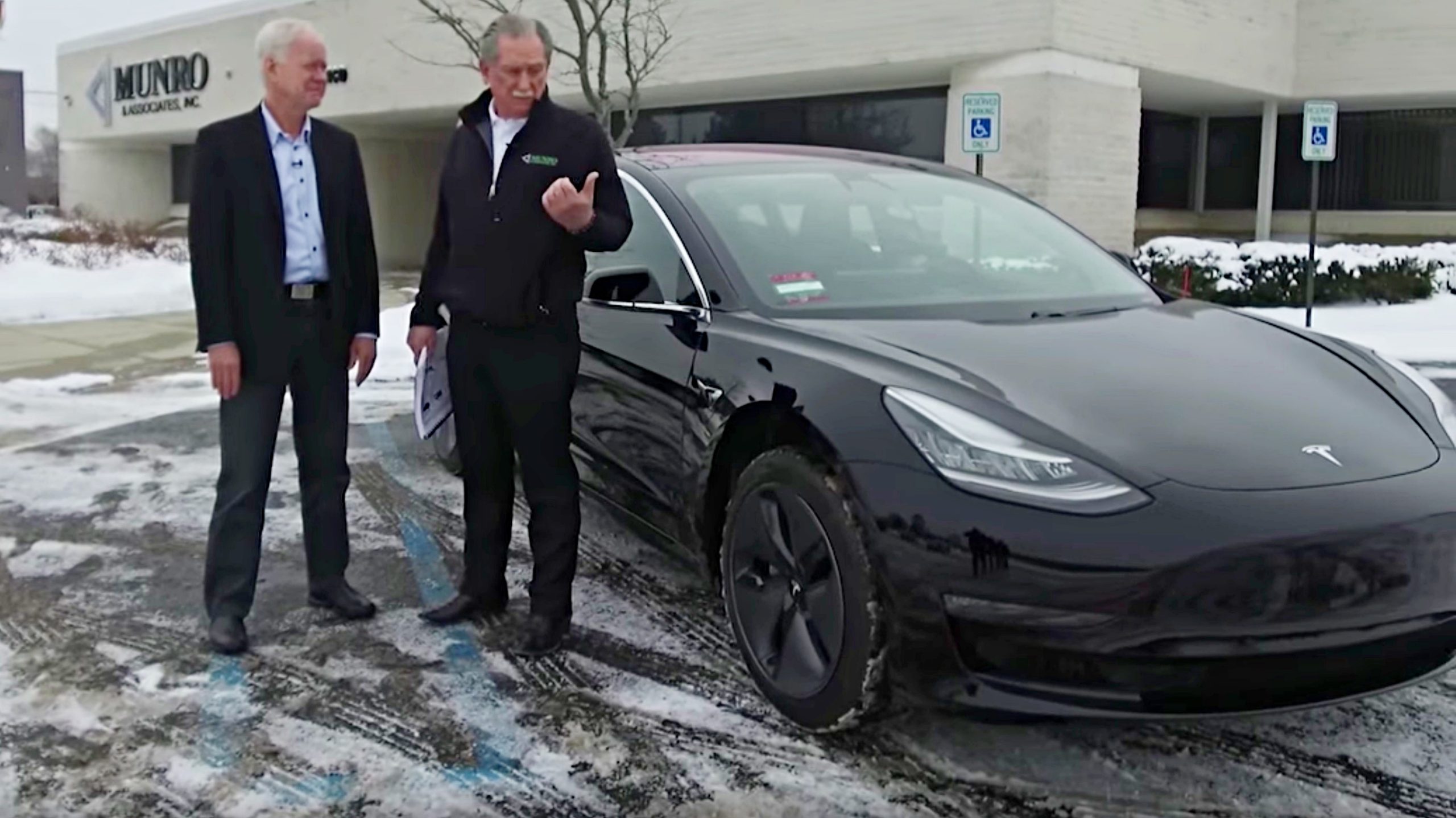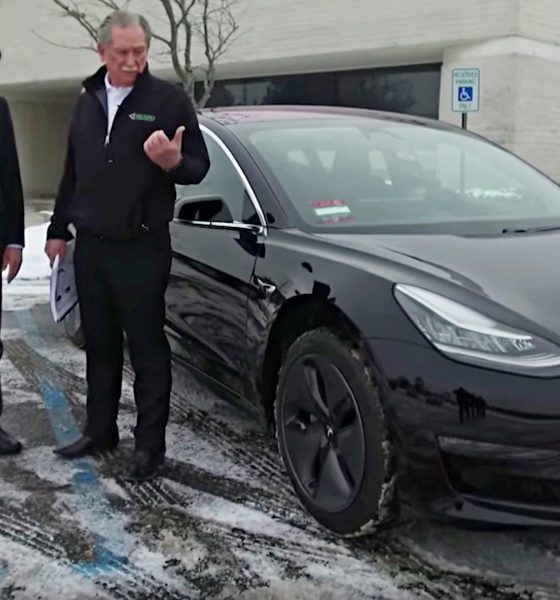

News
Tesla Model 3 critic has change of heart after test drive
After strongly criticizing the Tesla Model 3 for its build quality and alleged safety issues, Sandy Munro of Munro & Associates said that he and his team were actually impressed with the performance and driving capabilities of the mass market compact electric car.
Munro’s further observations on the Model 3 were featured in a new Autoline Network YouTube video, where the Detroit veteran took the electric car for a brief drive with host John McElroy. Quite unlike their first video, when the two automotive veterans almost had nothing positive to say about the electric car, Sandy Munro took an entirely different stance when talking about the actual capabilities of the vehicle.
While driving the vehicle around, Munro and McElroy immediately gave positive comments on the car’s simplistic, clean look. One thing that the Detroit veteran was particularly impressed with, however, was the Model 3’s HVAC system, which he called “brilliant.”
Munro did note, however, that the HVAC system’s onscreen controls take a few taps to access. He was also not a fan of the car’s 15-inch center console, which he believes can be detrimental to drivers. Overall, however, Munro stated that his team was impressed with how the car performed during driving tests on the Transportation Research Center, especially with regards to responsiveness and control.
“Actually, we kind of liked the car. It’s a very good drive. This is very responsive. You feel in control when you’re driving this car, and we like that a lot,” the Detroit veteran said.
Munro further asserted that his team was made up of seasoned auto professionals. Despite their experience in the auto industry, however, the Detroit veteran noted that his team was happy with the performance of the Model 3, particularly its acceleration and handling.
“The acceleration, everybody loved. The handling, everybody loved.”
The Munro & Associates CEO also discussed his team’s other observations about the electric car, such as its under chassis and how it was evident that the Model 3’s design has allowances for a dual motor, all-wheel drive. Munro also discussed a noise his team reported from the car’s electric motor during high-speed driving. The auto veteran also mentioned that his team had developed a liking for the Model 3’s Sport Mode, which brings out the car’s true potential.
When the Autoline Network host asked Munro what he thought of the electric car’s overall driving capability, the Detroit veteran admitted that he actually liked the way the electric car carried itself on the road.
Munro asserted, however, that his team is still in the process of analyzing and testing the Model 3 and thus, the vehicle’s full scores and ratings are still up for question. For now, however, Munro noted that while the Model 3 failed in fit and finish, he is quite confident that the Model 3 scored well on an important metric — ride and drive.
“I like the drive, I did. I gave it pretty high marks. I know that nothing counts until we see all the profile tests and things like that, but for me, this was a pretty good experience. So I’m pretty hopeful and pretty confident that we’re gonna see a pretty good outcome on ride and drive.”
As we noted in a previous article, Munro gave the Model 3 a brutal critique of the car’s fit and finish and its safety features, even noting at one point that he could not imagine how Tesla could release such a vehicle to the market. The Munro & Associates CEO even remarked at one point that the Model 3, as a whole, was a miserable job that was created by “electronic snobs.”

Elon Musk
Starlink passes 9 million active customers just weeks after hitting 8 million
The milestone highlights the accelerating growth of Starlink, which has now been adding over 20,000 new users per day.

SpaceX’s Starlink satellite internet service has continued its rapid global expansion, surpassing 9 million active customers just weeks after crossing the 8 million mark.
The milestone highlights the accelerating growth of Starlink, which has now been adding over 20,000 new users per day.
9 million customers
In a post on X, SpaceX stated that Starlink now serves over 9 million active users across 155 countries, territories, and markets. The company reached 8 million customers in early November, meaning it added roughly 1 million subscribers in under seven weeks, or about 21,275 new users on average per day.
“Starlink is connecting more than 9M active customers with high-speed internet across 155 countries, territories, and many other markets,” Starlink wrote in a post on its official X account. SpaceX President Gwynne Shotwell also celebrated the milestone on X. “A huge thank you to all of our customers and congrats to the Starlink team for such an incredible product,” she wrote.
That growth rate reflects both rising demand for broadband in underserved regions and Starlink’s expanding satellite constellation, which now includes more than 9,000 low-Earth-orbit satellites designed to deliver high-speed, low-latency internet worldwide.
Starlink’s momentum
Starlink’s momentum has been building up. SpaceX reported 4.6 million Starlink customers in December 2024, followed by 7 million by August 2025, and 8 million customers in November. Independent data also suggests Starlink usage is rising sharply, with Cloudflare reporting that global web traffic from Starlink users more than doubled in 2025, as noted in an Insider report.
Starlink’s momentum is increasingly tied to SpaceX’s broader financial outlook. Elon Musk has said the satellite network is “by far” the company’s largest revenue driver, and reports suggest SpaceX may be positioning itself for an initial public offering as soon as next year, with valuations estimated as high as $1.5 trillion. Musk has also suggested in the past that Starlink could have its own IPO in the future.
News
NVIDIA Director of Robotics: Tesla FSD v14 is the first AI to pass the “Physical Turing Test”
After testing FSD v14, Fan stated that his experience with FSD felt magical at first, but it soon started to feel like a routine.

NVIDIA Director of Robotics Jim Fan has praised Tesla’s Full Self-Driving (Supervised) v14 as the first AI to pass what he described as a “Physical Turing Test.”
After testing FSD v14, Fan stated that his experience with FSD felt magical at first, but it soon started to feel like a routine. And just like smartphones today, removing it now would “actively hurt.”
Jim Fan’s hands-on FSD v14 impressions
Fan, a leading researcher in embodied AI who is currently solving Physical AI at NVIDIA and spearheading the company’s Project GR00T initiative, noted that he actually was late to the Tesla game. He was, however, one of the first to try out FSD v14.
“I was very late to own a Tesla but among the earliest to try out FSD v14. It’s perhaps the first time I experience an AI that passes the Physical Turing Test: after a long day at work, you press a button, lay back, and couldn’t tell if a neural net or a human drove you home,” Fan wrote in a post on X.
Fan added: “Despite knowing exactly how robot learning works, I still find it magical watching the steering wheel turn by itself. First it feels surreal, next it becomes routine. Then, like the smartphone, taking it away actively hurts. This is how humanity gets rewired and glued to god-like technologies.”
The Physical Turing Test
The original Turing Test was conceived by Alan Turing in 1950, and it was aimed at determining if a machine could exhibit behavior that is equivalent to or indistinguishable from a human. By focusing on text-based conversations, the original Turing Test set a high bar for natural language processing and machine learning.
This test has been passed by today’s large language models. However, the capability to converse in a humanlike manner is a completely different challenge from performing real-world problem-solving or physical interactions. Thus, Fan introduced the Physical Turing Test, which challenges AI systems to demonstrate intelligence through physical actions.
Based on Fan’s comments, Tesla has demonstrated these intelligent physical actions with FSD v14. Elon Musk agreed with the NVIDIA executive, stating in a post on X that with FSD v14, “you can sense the sentience maturing.” Musk also praised Tesla AI, calling it the best “real-world AI” today.
News
Tesla AI team burns the Christmas midnight oil by releasing FSD v14.2.2.1
The update was released just a day after FSD v14.2.2 started rolling out to customers.

Tesla is burning the midnight oil this Christmas, with the Tesla AI team quietly rolling out Full Self-Driving (Supervised) v14.2.2.1 just a day after FSD v14.2.2 started rolling out to customers.
Tesla owner shares insights on FSD v14.2.2.1
Longtime Tesla owner and FSD tester @BLKMDL3 shared some insights following several drives with FSD v14.2.2.1 in rainy Los Angeles conditions with standing water and faded lane lines. He reported zero steering hesitation or stutter, confident lane changes, and maneuvers executed with precision that evoked the performance of Tesla’s driverless Robotaxis in Austin.
Parking performance impressed, with most spots nailed perfectly, including tight, sharp turns, in single attempts without shaky steering. One minor offset happened only due to another vehicle that was parked over the line, which FSD accommodated by a few extra inches. In rain that typically erases road markings, FSD visualized lanes and turn lines better than humans, positioning itself flawlessly when entering new streets as well.
“Took it up a dark, wet, and twisty canyon road up and down the hill tonight and it went very well as to be expected. Stayed centered in the lane, kept speed well and gives a confidence inspiring steering feel where it handles these curvy roads better than the majority of human drivers,” the Tesla owner wrote in a post on X.
Tesla’s FSD v14.2.2 update
Just a day before FSD v14.2.2.1’s release, Tesla rolled out FSD v14.2.2, which was focused on smoother real-world performance, better obstacle awareness, and precise end-of-trip routing. According to the update’s release notes, FSD v14.2.2 upgrades the vision encoder neural network with higher resolution features, enhancing detection of emergency vehicles, road obstacles, and human gestures.
New Arrival Options also allowed users to select preferred drop-off styles, such as Parking Lot, Street, Driveway, Parking Garage, or Curbside, with the navigation pin automatically adjusting to the ideal spot. Other refinements include pulling over for emergency vehicles, real-time vision-based detours for blocked roads, improved gate and debris handling, and Speed Profiles for customized driving styles.








